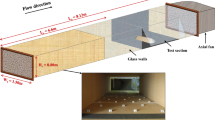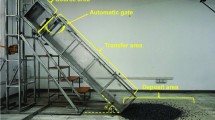Abstract
Aeolian erosion of granular materials is investigated by means of a mathematical emission model and experimental wind tunnel measurements. Main model input data are: friction velocity, relationship between cover rate (CR) and eroded height (H) and particle properties (density, size distribution). It is proposed: (1) to evaluate the linearity of the relation between CR and H considering the presence of a multimodal distribution of particle sizes, (2) to validate the mathematical model with wind tunnel data, (3) to evaluate the protective effect of non-erodible particles and (4) to qualitatively evaluate the final stage of erosion through experimental photographs of the oblong stockpile. The relationship between CR and H may still be considered linear for the tested mixture of particles. The modelled emission, when compared with experimental data, showed that the physical tendency of the aeolian erosion phenomenon was well predicted. The model showed to be useful in comparative analysis between scenarios but not in absolute values due to errors found. It is valid for the monitoring of air quality degradation due to aeolian erosion of open yards of storage piles. Detailed analysis of emitted mass explained that the smallest diameters among the non-erodible particles create a less effective protection effect leading to higher emissions. The qualitative analysis of high-quality photographs of the experiments showed that the non-erodible particle agglomeration on the stockpile surface can be well explained if one evaluates simultaneously, on the pile, the angle of velocity vectors (which influences the threshold friction velocity value) and shear stress.
Similar content being viewed by others
References
Badr T, Harion J-L (2005) Numerical modelling of flow over stockpiles: implications on dust emissions. Atmos Environ 39(30):5576–5584. https://doi.org/10.1016/j.atmosenv.2005.05.053
Badr T, Harion J-L (2007) Effect of aggregate storage piles configuration on dust emissions. Atmos Environ 41(2):360–368. https://doi.org/10.1016/j.atmosenv.2006.07.038
Caliman MFSC (2017) Influence of non-erodible particles on wind erosion. Doctoral thesis. Universidade Federal do Espírito Santo, Vitória, ES
Cong X, Yang S, Cao S, Chen Z, Dai M, Peng S (2012) Effect of aggregate stockpile configuration and layout on dust emissions in an open yard. Appl Math Model 36(11):5482–5491. https://doi.org/10.1016/j.apm.2012.01.014
Crawley D, Nickling W (2003) Drag partition for regularly-arrayed rough surfaces. Bound-Layer Meteorol 107(2):445–468. https://doi.org/10.1023/a:1022119909546
Derakhshani SM, Schott DL, Lodewijks G (2013) Dust emission modelling around a stockpile by using computational fluid dynamics and discrete element method. AIP Conf Proc 1542(2013):1055–1058. https://doi.org/10.1063/1.4812116
Descamps I, Harion J-L, Baudoin B (2005) Taking-off model of particles with a wide size distribution. Chem Eng Process 44(2):159–166. https://doi.org/10.1016/j.cep.2004.04.007
Diego I, Pelegry A, Torno S, Toraño J, Menendez M (2009) Simultaneous CFD evaluation of wind flow and dust emission in open storage piles. Appl Math Model 33(7):3197–3207. https://doi.org/10.1016/j.apm.2008.10.037
Dong Z, Wang H, Liu X, Wang X (2004) A wind tunnel investigation of the influences of fetch length on the flux profile of a sand cloud blowing over a gravel surface. Earth Surf Process Landf 29(13):1613–1626. https://doi.org/10.1002/esp.1116
Faria R, Ferreira AD, Sismeiro JL, Mendes JCF, Sousa ACM (2011) Wind tunnel and computational study of the stoss slope effect on the aeolian erosion of transverse sand dunes. Aeol Res 3:303–314. https://doi.org/10.1016/j.aeolia.2011.07.004
Ferreira AD, Pinheiro SR, Francisco SC (2013) Experimental and numerical study on the shear velocity distribution along one or two dunes in tandem. Environ Fluid Mech 13:557–570. https://doi.org/10.1007/s10652-013-9282-7
Furieri B, Russeil S, Santos JM, Harion J-L (2013) Effects of non-erodible particles on aeolian erosion: wind-tunnel simulations of a sand oblong storage pile. Atmos Environ 79:672–680. https://doi.org/10.1016/j.atmosenv.2013.07.026
Furieri B, Harion JL, Milliez M, Russeil S, Santos JM (2013) Numerical modelling of aeolian erosion over a surface with non-uniformly distributed roughness elements. Earth Surf Proc Land 39(2):156–166. https://doi.org/10.1002/esp.3435
Furieri B, Santos JM, Russeil S (2014) Aeolian erosion of storage piles yard: contribution of the surrounding areas. Environ Fluid Mech 14:51–67. https://doi.org/10.1007/s10652-013-9293-4
Gillette D, Stockton P (1989) The effect of nonerodible particles on wind erosion of erodible surfaces. J Geophys Res Atmos 94(D10):12885–12893. https://doi.org/10.1029/JD094iD10p12885
Gillies J, Nickling W, King J (2007) Shear stress partitioning in large patches of roughness in the atmospheric inertial sublayer. Bound-Layer Meteorol 122(2):367–396. https://doi.org/10.1007/s10546-006-9101-5
Gillies JA, Green H, McCarley-Holder G, Grimm S, Howard C, Barbieri N, Ono D, Schade T (2015) Using solid element roughness to control sand movement: Keeler Dunes, Keeler, California. Aeolian Res 18:35–46. https://doi.org/10.1016/j.aeolia.2015.05.004
Hoonhout BM, De Vries S (2016) A process-based model for aeolian sediment transport and spatiotemporal varying sediment availability. J Geophys Res Earth Surf 121:1555–1575. https://doi.org/10.1002/2015JF003692
Iversen J, Wang W, Rasmussen K, Mikkelsen H, Leach R (1991) Roughness element effect on local and universal saltation transport. In: Barndorff-Nielsen O, Willetts B (eds) Aeolian grain transport: acta mechanica supplementum, vol 2. Springer, Vienna, pp 65–75
Iversen J, Rasmussen K (1994) The effect of surface slope on saltation threshold. Sedimentology 41(4):721–728. https://doi.org/10.1111/j.1365-3091.1994.tb01419.x
Klose M, Shao Y, Li X, Zhang H, Ishizuka M, Mikami M, Leys JF (2014) Further development of a parametrization for convective turbulent dust emission and evaluation based on field observations. J Geophys Res Atmos 119(17):10441–10457. https://doi.org/10.1002/2014JD021688
Kok J, Mahowald N, Fratini G, Gillies J, Ishizuka M, Leys J, Mikami M, Park M-S, Park S-U, Van Pelt R, Zobeck T (2014) An improved dust emission model—Part 1: model description and comparison against measurements. Atmos Chem Phys 14(23):13023–13041. https://doi.org/10.5194/acp-14-13023-2014
Kurose R, Komori S (2001) Turbulence structure over a particle roughness. Int J Multiph Flow 27(4):673–683. https://doi.org/10.1016/S0301-9322(00)00044-6
Lyles L, Allison B (1975) Wind erosion: the protective role of simulated standing stubble. Am Soc Agric Eng 19(1):61–64
Marshall J (1971) Drag measurements in roughness arrays of varying density and distribution. Agric Meteorol 8:269–292. https://doi.org/10.1016/0002-1571(71)90116-6
Marticorena B, Bergametti G (1995) Modeling the atmospheric dust cycle: 1. Design of a soil-derived dust emission scheme. J Geophys Res Atmos 100(D8):16415–16430. https://doi.org/10.1029/95JD00690
Mckenna Neuman C, Nickling W (1995) Aeolian sediment flux decay: nonlinear behaviour on developing deflation lag surfaces. Earth Surf Proc Land 20(5):423–435. https://doi.org/10.1002/esp.3290200504
Miri A, Dragovich D, Dong Z (2017) Vegetation morphologic and aerodynamic characteristics reduce aeolian erosion. Nat Sci Rep 7:12831. https://doi.org/10.1038/s41598-017-13084-x
Mollinger A, Nieuwstadt F (1996) Measurement of the lift force on a particle fixed to the wall in the sublayer of a fully developed turbulent boundary layer. J Fluid Mech 316:285–306. https://doi.org/10.1017/S0022112096000547
Musick HB, Gillette DA (1990) Field evaluation of relationships between a vegetation structural parameter and sheltering against wind erosion. Land Degrad Dev 2(2):87–94. https://doi.org/10.1002/ldr.3400020203
Nickling W, McKenna Neuman C (1995) Development of deflation lag surfaces. Sedimentology 42(3):403–414
Novak L, Bizjan B, Pražnikar J, Horvat B, Orbanić A, Širok B (2015) Numerical modeling of dust lifting from a complex-geometry industrial stockpile. J Mech Eng 61(11):621–631. https://doi.org/10.5545/sv-jme.2015.2824
Raupach M, Gillette D, Leys J (1993) The effect of roughness elements on wind erosion threshold. J Geophys Res Atmos 98(D2):3023–3029. https://doi.org/10.1029/92JD01922
Shao Y, Lu H (2000) A simple expression for wind erosion threshold friction velocity. J Geophys Res Atmos 105(D17):22437–22443. https://doi.org/10.1029/2000JD900304
Tan L, Zhang W, Qu J, Zhang K, An Z, Wang X (2013) Aeolian sand transport over gobi with different gravel coverages under limited sand supply: a mobile wind tunnel investigation. Aeol Res 11:67–74. https://doi.org/10.1016/j.aeolia.2013.10.003
Turpin C, Badr T, Harion J-L (2010) Numerical modelling of aeolian erosion over rough surfaces. Earth Surf Proc Land 35(12):1418–1429. https://doi.org/10.1002/esp.1980
US Environmental Protection Agency (2006) Miscellaneous Sources. Industrial Wind Erosion. AP-42
Zou X, Zhang C, Cheng H, Kang L, Wu Y (2015) Cogitation on developing a dynamic model of soil wind erosion. Earth Sci 58(3):462–473. https://doi.org/10.1007/s11430-014-5002-5
Acknowledgements
This work was carried out with the financial support of CAPES and CNPq.
Author information
Authors and Affiliations
Corresponding author
Rights and permissions
About this article
Cite this article
de Morais, C.L., Ferreira, M.C.S., Santos, J.M. et al. Influence of non-erodible particles with multimodal size distribution on aeolian erosion of storage piles of granular materials. Environ Fluid Mech 19, 583–599 (2019). https://doi.org/10.1007/s10652-018-9640-6
Received:
Accepted:
Published:
Issue Date:
DOI: https://doi.org/10.1007/s10652-018-9640-6













